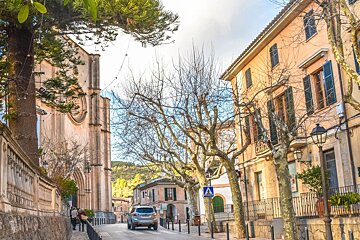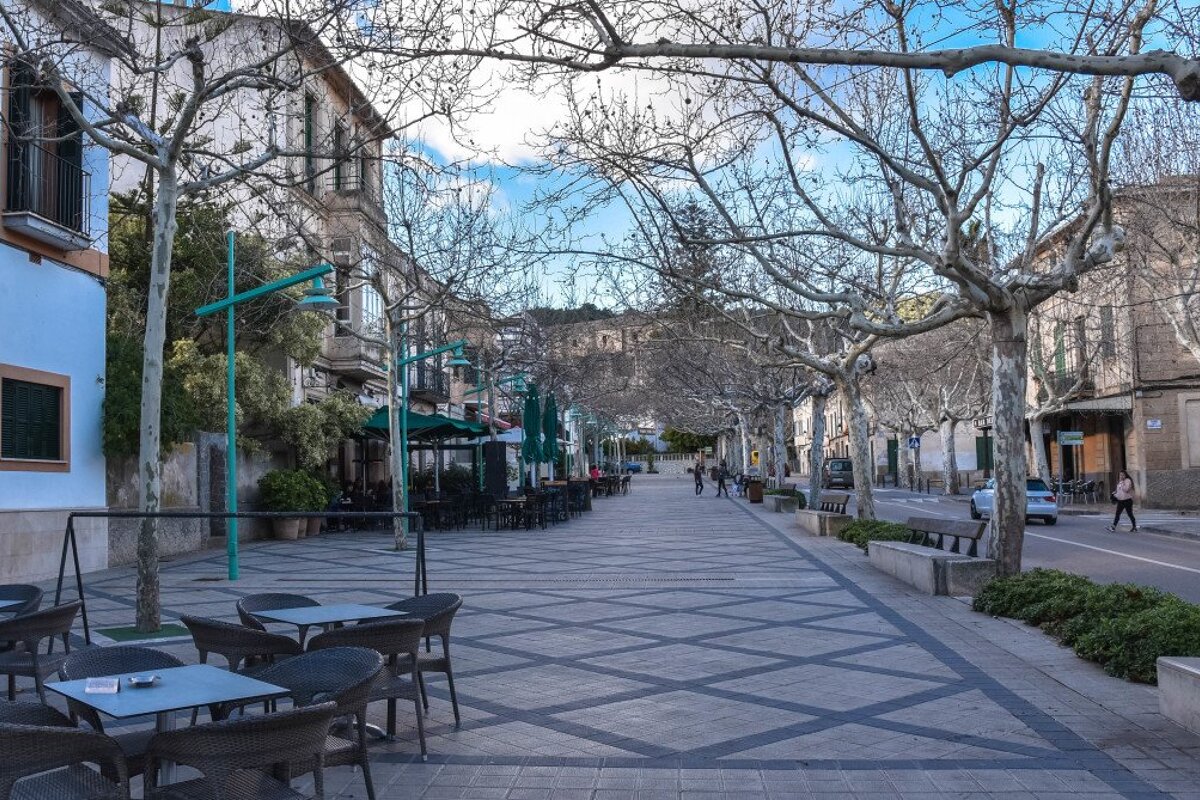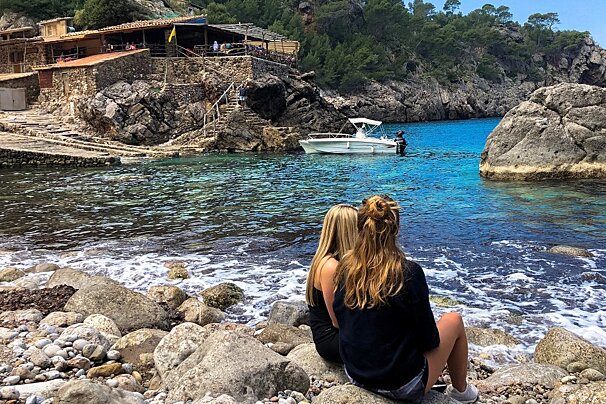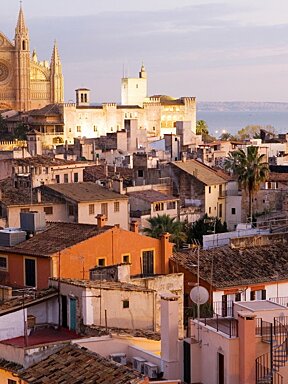
© Jose Rains

© Jose Rains

© Jose Rains

© Jose Rains

© Jose Rains

© Jose Rains

© Jose Rains

© Jose Rains

© Jose Rains

© Jose Rains

© Jose Rains
Esporles, Mallorca
Charming little village in a valley on the south side of the Serra de Tramuntana
Esporles is one of Mallorca’s best-kept secrets, a wonderfully pretty place thanks to the well-preserved traditional blonde stone architecture and stunning setting in the Serra de Tramuntana mountains.
Esporles is still very much a quiet place, with just a few bare necessities like a tobacconist, pharmacy and a couple of boutique shops. Carrer de sa Rectoria, the main street, is lined with majestic looking trees and fringed by a torrent running through the village. On the other side of the road, you will find a wide pedestrianised promenade with some cafes and restaurants.
Off the main street, there are lots of quaint narrow lanes with more of the same blonde stone houses, many of which have some spectacular views of the surrounding valley. At the furthest western point of Carrer de sa Rectoria, in the direction of Banyalbufar, you will be charmed by the dominant Neo-Gothic church standing tall.
Esporles and its suburbs appear to be untouched by tourism, which is probably why an affluent expat community have been drawn here. It’s a handsome village, just 20 minutes from Palma, making it a desirable place to live and this is reflected in the house prices in the area, comparable to other prestigious mountain villages like Deia and Valldemossa.
History & Culture in [locality]
The Moors established Esporles in the early Middle Ages and it was further developed in the 12th century when the Catalan troops conquered the Muslim city of Medina Mayurqa in 1229. The first parish church of Esporles was already mentioned in 1248 but it was developed over the years and a grand neo-Gothic church now stands in its place. The oratory is dedicated to Sant Crist de la Pois, patron saint of the long-gone textile industry. There was once a time in Esporles where textiles prospered due to the good amount of rainfall and water systems, although the factories are now either in ruins or been converted into housing. The residents of Esporles also relied upon agriculture, traditionally orange trees, almond trees and livestock were their main assets to make a living.
Sights & Attractions in [locality]
On the road out of the village towards Banyalbufar is where you will find La Granja, a museum dedicated to the history and traditions of Mallorca. The grounds consist of a beautiful 17th-century mansion surrounded by lush vegetation, stunning gardens and natural springs. As soon as you set foot on the estate, you will be transported back in time to 400 years ago. From seeing arts and crafts from this era, through to how the locals used to make oil, process grain and manufacture paper. You will see artisans working with iron clay and even get to visit a medieval torture chamber. There’s also a restaurant and café serving traditional local products, a fabulous terrace, and a children’s play area. The perfect ingredients for a family day out.
The dry stone terraces around the neighbouring village of Banyalbufar are also a must-see. From the road, as you enter the village, you will see hundreds of ledges falling down into the sea, but there’s very good reason for this. The Moors famously settled in this area during the 10th century and cultivated around 2000 dry stone terraces on the mountain slopes, making the most out of the farmland on the inhospitable steep hills, along with a sophisticated irrigation system of aqueducts which are still in use today.
Events in [locality]
Esporles famously hosts the Fira Dolça food festival in October, where people travel from all over the island to celebrate sweet treats produced on the island. Otherwise, there are a few small fiestas held for locals throughout the year in the small village like the Festes de Sa Vilanova, in honour of the month of August. Within these festivities, the Eucharist of Esporles, otherwise known as ‘the Last Supper’, takes place at the end of July. It starts with a procession of locals walking together to the Hermitage of Maristell, however, the paella contest is the main event for many. Keep an eye on our events calendar for any updates.
Things to do in [locality]
Being a sleepy rural village, Esporles is the kind of place you just want to sit down with a coffee and soak up the spectacular scenery. Its main visitors are those who plan to trek the ancient paths or attempt the challenging cycle routes this part of the island has to offer.
Cycling
Located within a valley of the Serra de Tramuntana, Esporles is a popular place for cyclists to either base themselves or just make a pit-stop. During the springtime, you will certainly spot some cycling lycra around the village whether it be in the local hotels or making the most of the scenery in one of the little cafes. From here to Banyalbufar, cyclists can be seen tackling the winding roads, steep climbs and descents.
Hiking
Hiking is the only way to see some of Mallorca’s best bits, and this part of the island is full of walking enthusiasts in the cooler months. The most popular hike here is the Old Postman’s Route from Banyalbufar to Esporles which forms part of the GR221 or Dry Stone Route and offers some of the best views of the terraced landscape, holm oak woods, natural springs, and sea views. You can also complete another part of the Dry Stone Route by taking the path to Valldemossa, although much of this is through dense oak forest which means the views aren’t as impressive.
Wine tasting
Es Verger is a family-run vineyard, famous for producing some of the first 100% ecological wines on the island. If you can, take the opportunity to visit this reputable bodega which not only has a wine cellar but a working olive oil mill on the farm.
Dining in [locality]
If you want to try some of the best suckling pig on the island, then the reputable Mesón La Villa should be on your list of restaurants to go to. It’s a typical Castillian steakhouse with a traditional wood oven within a rustic and cosy setting. Another establishment favoured by locals and tourists alike is Restaurante Quay within Loftotel Canet. The terrace and garden are one of its many alluring features, although many will be drawn to this place because the food is made with only the freshest local organic ingredients.
Hotels in [locality]
Boutique hotels are the way to go in Esporles and they have a more than worthy selection on offer. You will find a relaxing rural retreat within the Agroturismo Son Galceran, hosted in an 18th-century estate with a large swimming pool. Rooms are quite traditionally styled but have all the modern amenities one could want for. However, it’s the views of the valley that make this hotel stand out from the crowd.
Another serene holiday experience can be found at the 4-star La Posada del Marques. Set within a luxury 16th-century finca, it resides in the picture perfect countryside surrounding Esporles. This hotel retains much of its traditional architecture, whilst cleverly infusing some modern elements to create first-rate comfort. Loftotel Canet was once an old farmhouse which has been tastefully converted into a more modern 4-star hotel in the centre of Esporles, successfully creating a contemporary 21st-century feel whilst maintaining some of the special characteristics of the ancient architecture like its stone walls. The gardens are the perfect setting to relax but you won’t be alone here as there are 500 different plants and trees within the 40,000m2 estate.
How to get to [locality]
By car
On the west coast of Mallorca, Esporles is a simple 25-minute drive from Palma airport.
Public transport
From Palma airport, take the EMT bus number 1 to Palma's Plaça d'Espanya. Then you can catch the TIB bus number 200 from the bus station which runs between Esporles and Palma fairly frequently, leaving almost once every hour. This bus also connects Esporles with the nearby villages of Estellencs and Banyalbufar.




































